Bea 2009
'09 maps for:
Bea
--
Buck -- Caley --
Claws --
Conomo --
Hix --
Hudson 09 -- Isabel --
Katy -- L.R. --
Moffet --
Mr. Hannah --
Ozzie --
Penelope
--
Rafael
2010 maps for: Belle
-- Buck --
Gunny --
Hudson --
Mr. Hannah --
Neale --
North Fork Bob
--
Penelope --
Sanford
-- Sr. Bones --
Thatch
2011 maps:
Belle --
Buck --
Henrietta --
Katbird
-- North Fork Bob --
Pemi --
Saco --
Sanford --
Sr. Bones --
Snowy --
Thatch -- Tucker
2012 maps: Art --
Belle --
Bridger --
Chip --
Cutch --
Jill -- North Fork Bob --
Rammie --
Snowy --
Sr. Bones -- Thatch
2013 maps: Art --
Belle --
Bridger --
North Fork Bob --
Rammie --
Snowy --
Sr. Bones
Osprey
main page --
Migration
page --
Migration09 --
Migration10 --
Migration 11 --
Migration 12 --
Migration 13 -- Home
Page
````````````````````
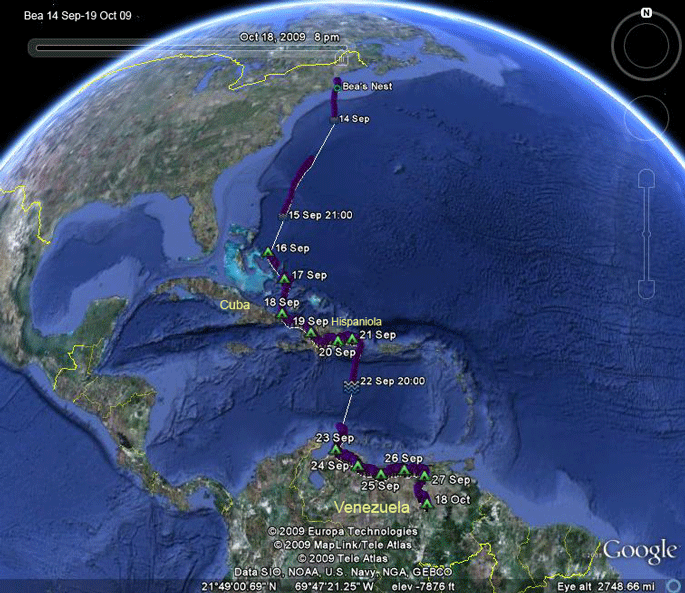 |
Travels so far: 14 Sep-3 Nov 09. Signal lost. Transmitter recovered
(sort of). We lost Bea's signal on 3 Nov in the middle of Venezuela. This is one that we have to put into the "unknown" category. She wasn't in an area with a lot of human activity, and seemed to be doing fine. It could be a bad transmitter (another of this year's batch failed and then restarted, so this is a possibility), but lots of other explanations are probably more likely. After never having been more that 2 miles from her nest, Bea crossed 1,200 miles of open Atlantic Ocean in 43 hours. She landed on Cat Island in the Bahamas a few hours before dawn on the 16th. She blasted through the Bahamas, Cuba, and Hispaniola, arriving in Venezuela only 10 days after leaving home. Bea moved east across Venezuela and has settled down at a series of reservoirs in north-central Venezuela. She moved south of the Orinoco, where we lost her signal on 3 November in the state of Bolivar. A month later we got a signal and now know that the transmitter has been recovered from her body. Scroll down for details on her travels. Skip to the last update. |
|
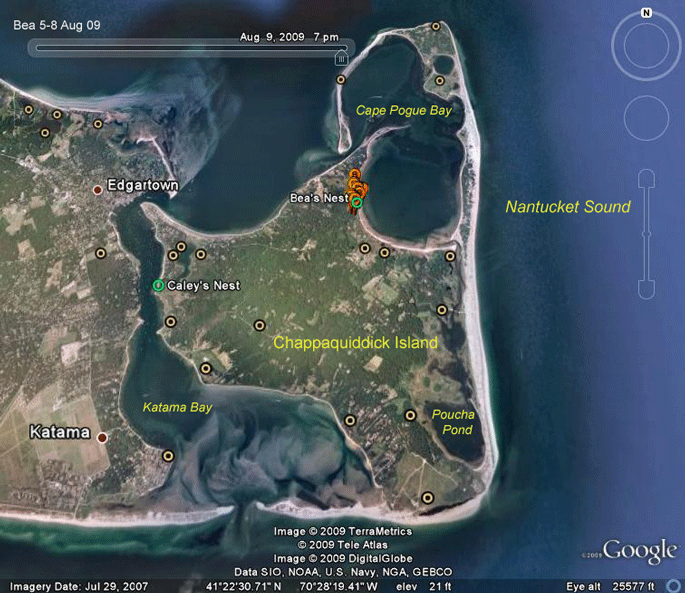 |
5-8 Aug 09. Bea's nest, on the west shore of Cape Pogue Bay, was one 13 active nests on Chappaquiddick Island in 2009 (the off-white donuts). Ospreys love to fish in shallow waters, so Chappy was clearly designed with them in mind. Cape Pogue, Katama Bay, and Poucha Pond all provide ideal fishing conditions. | |
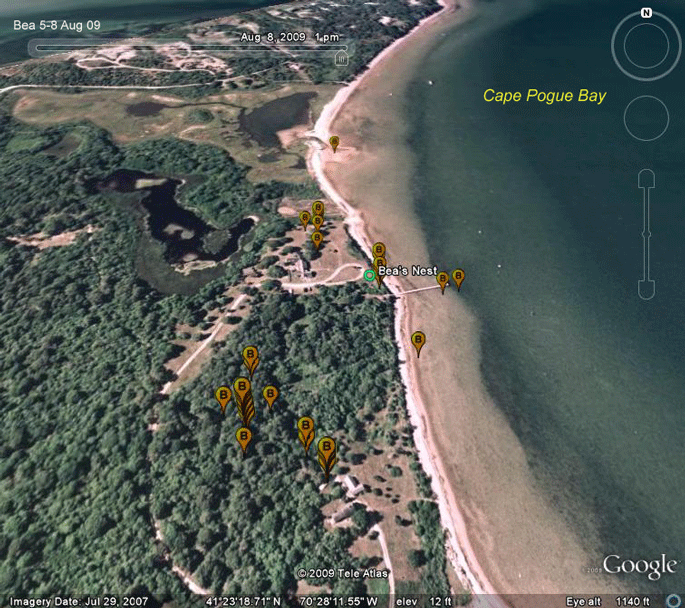 |
5-8 Aug 09. Bea was one of two young fledged from this productive nest. She isn't moving far from the nest yet. | |
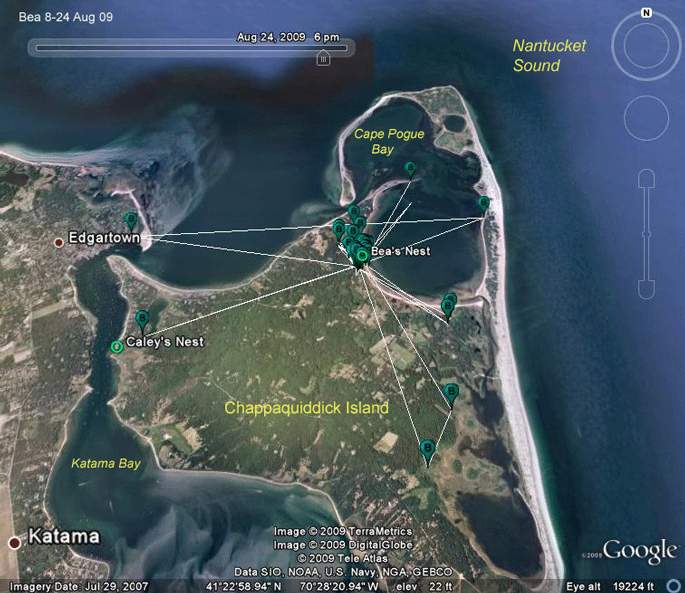 |
8-24 Aug 09. Bea is exploring a bit, having ventured at least once over to Edgartown. | |
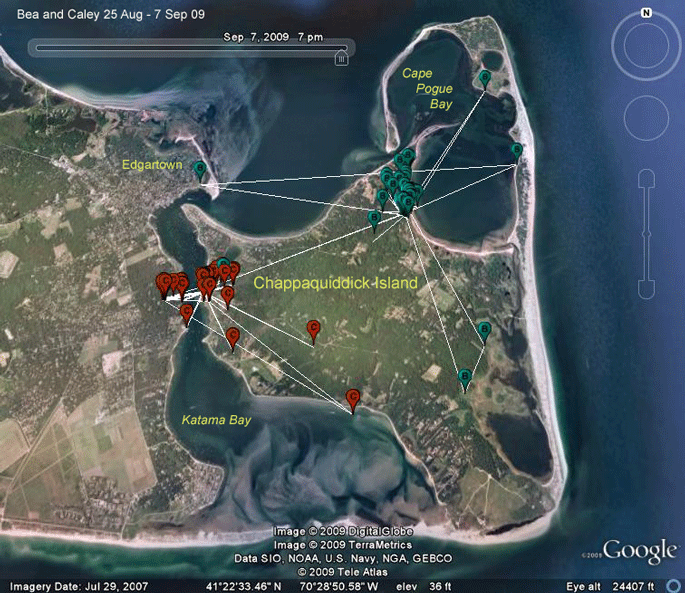 |
25 Aug-7 Sep 09. Bea and Caley are vying for
the Couch-Potato-of-the-year award. The human residents of "Chappy" are
notoriously loathe to leave their small island, but I didn't know the
affliction crossed species lines. These are all the locations for over 2
weeks. Caley has ventured afield some, but Bea really never has. It's quite unusual to have these two birds staying so close to their nests when one of their "classmates" is already in the Bahamas, Hix is in Maine, and Buck is hundreds of miles and 5 state lines from his nest. Every year brings its surprises. |
|
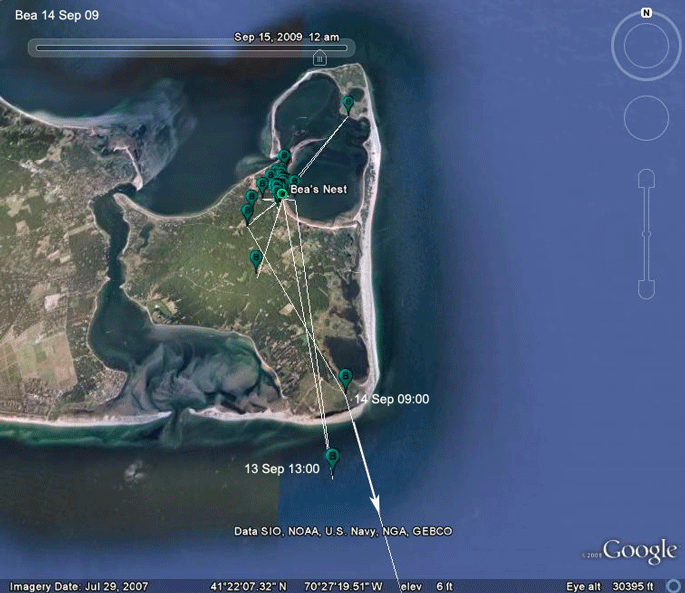 |
7-14 Sep 09. Spurred by shortening day length
and a stong NE wind, Bea made an aborted start to migration on the 13th,
apparently, but changed her mind. Maybe she forgot something? That was
the first time she was more than 2 miles from her nest in her life. On
the 14th she took off, this time for real. 43 hours later.... |
|
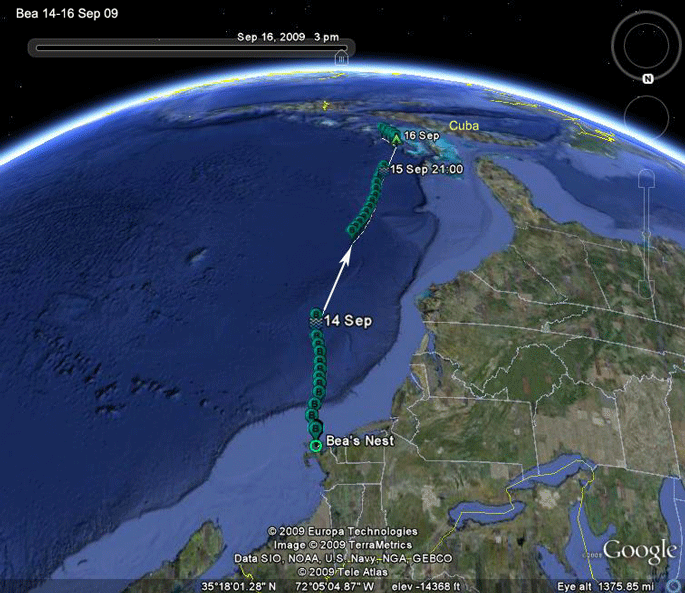 |
14-16 Sep 09. Looking south, we see Bea's trip across this corner of the Atlantic. She covered 1,212 mi. (1,951 km) in 43 hours, averaging 28 mph (45 kph). | |
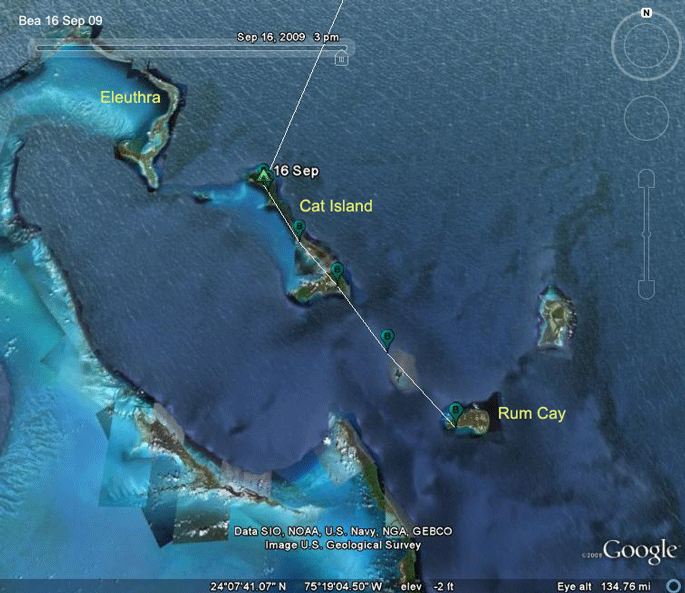 |
16 Sep 09. (Back to looking north) Bea arrived on Cat Island in the Bahamas around 04:00. About 11:00 she was off again. Our last signal for the day was on Rum Cay (I thought Bea and I had something in common). My guess is that she kept on going. We'll find out in 3 days. I suspect she'll be on Hispaniola--or beyond--by then. | |
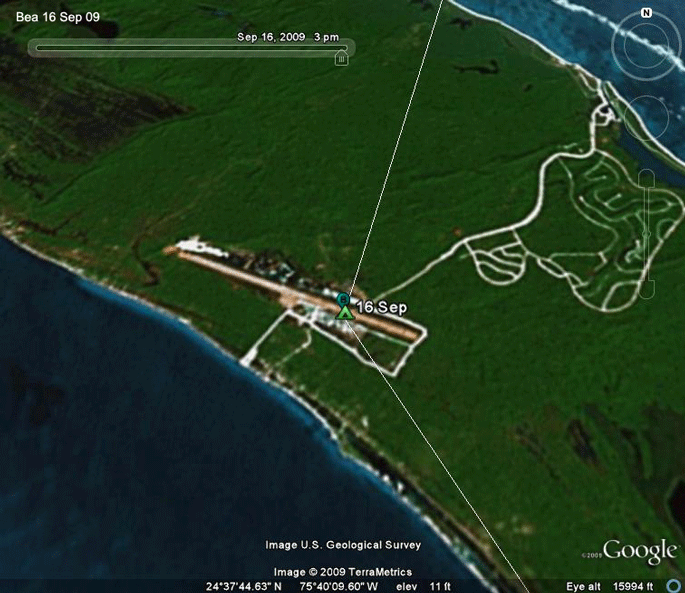 |
16 Sep 09. Couldn't resist including this--Bea touched down on Cat Island on an airport runway! | |
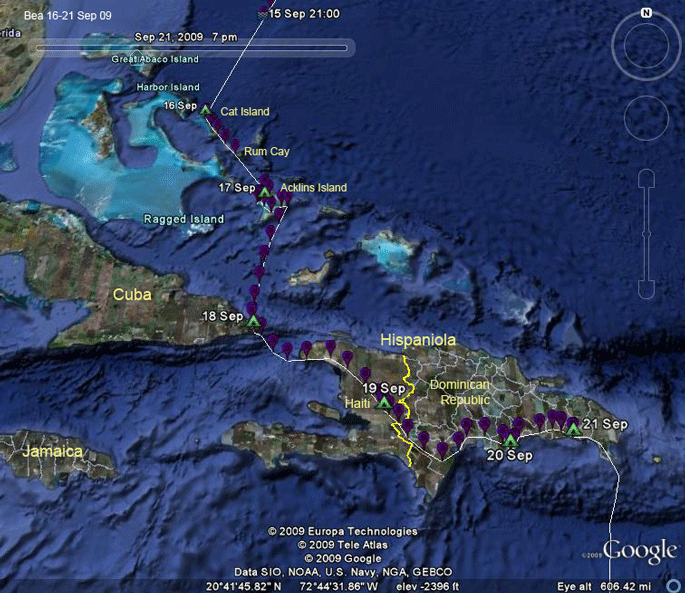 |
16-21 Sep 09. Bea made
short work of the rest of the Greater Antilles. Her only concerted rest
of any sort was on Acklins Island, where it looks like she spent some
time fishing. She left there at noon on the 17th. On the 21st she was in the eastern D.R., making us nervous. After losing four out of four young Ospreys that tried to overwinter in this half of Hispaniola, we're a bit gun shy and really like to see our birds head for South America. |
|
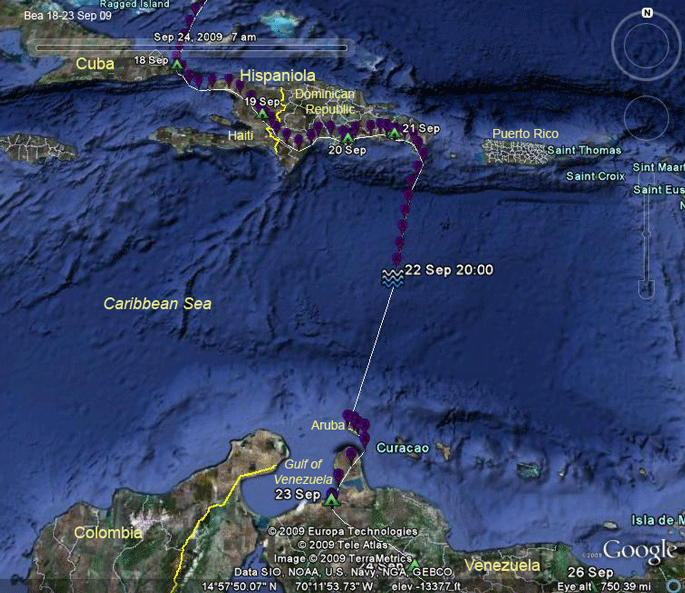 |
21-23 Sep 09. Bea buzzed across the Caribbean, leaving the D.R. at 11:00 local time on the 22nd. She made landfall on Aruba, but kept right on flying, spending little time there, and finally roosting in Venezuela, just east of the Gulf of Venezuela. | |
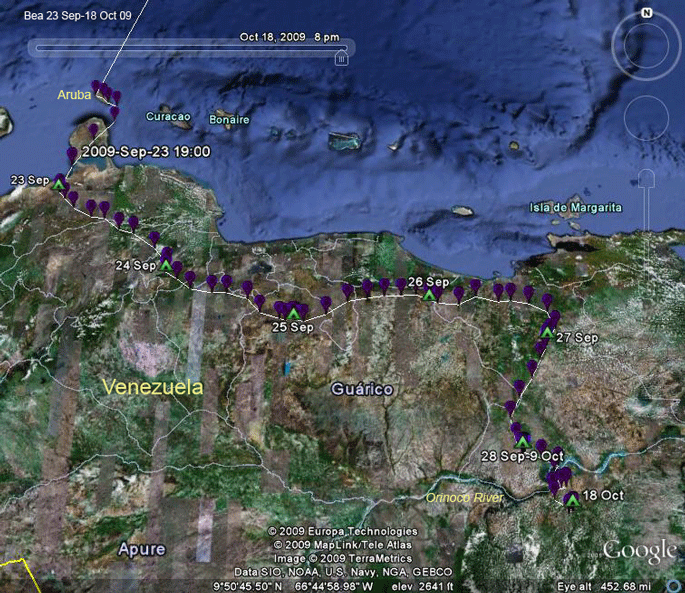 |
23 Sep-18 Oct 09. Pretty standard stuff here, moving east about 450 miles (724 km) across northern Venezuela before changing course for a more southerly route. | |
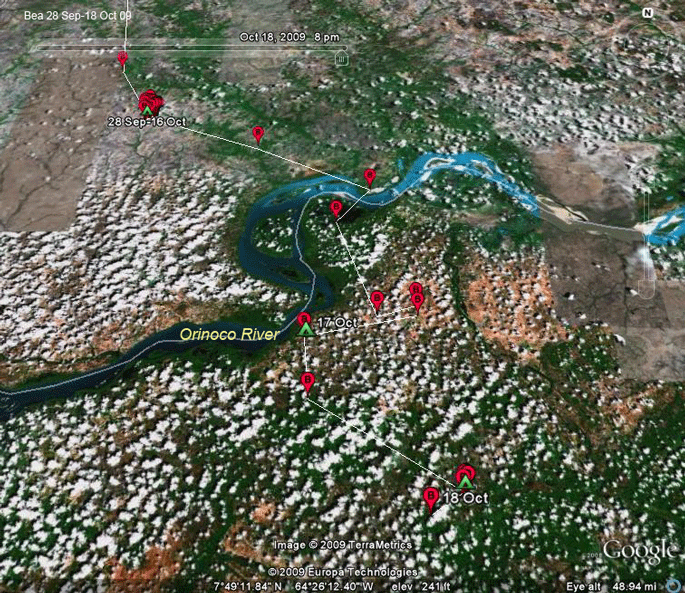 |
28 Sep-18 Oct 09. (Maybe leopards can't change
their spots, but my Ospreys can--she needed a new color to show up on
this map.) Bea seemed to be really settled in at a couple of small ponds
north of the Orinoco, but after almost three weeks she pulled out of
there and meandered south. These are the movements of a bird that is done with migration and is just looking for a really good fishing hole. Of course when I make a statement like that, the bird in question usually moves about 300 miles due south the next day. Could do, but I'd need pretty good odds to take that bet. Taking her 28 Sep-16 Oct area as the end of migration, she covered 3,151 miles (5,071 km) in 16 days of non-stop migration. She averaged 197 miles/day (317 Km/day). |
|
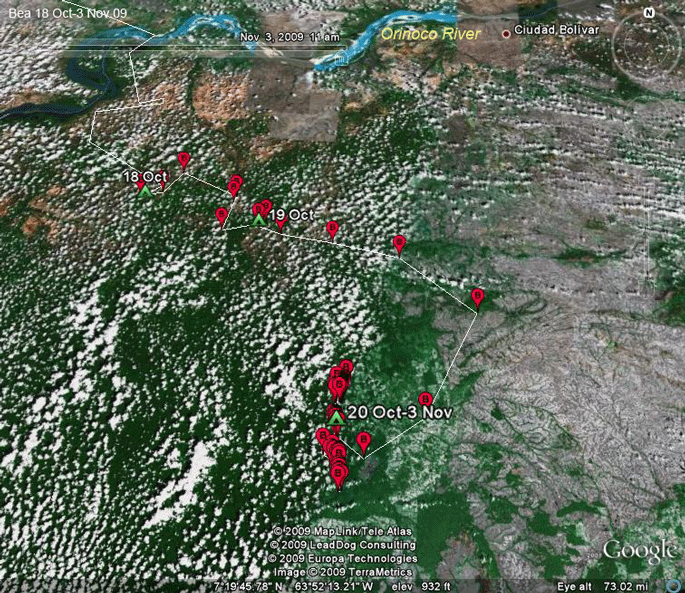 |
18 Oct-3 Nov 09. Bea
pushed east and south for two more days and then settled down along a
small, forested river that feeds into the Orinoco not far to the north. She was there for 2 weeks before going off the air. |
|
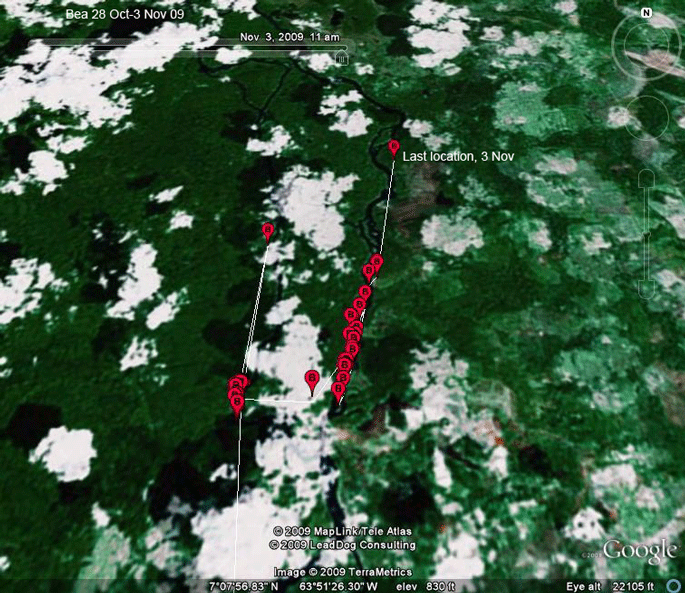 |
28 Oct-3 Nov 09. These are the last locations
for Bea. She was concentrating her hunting efforts along this narrow
forest river, just west of an area of extensive clearing. As the transmissions ceased abruptly, we don't know what happened to her. She's in a forested area, so if she died there, the solar panels are unlikely to recharge the batteries in the transmitter. We'll keep hoping this is a malfunctioning transmitter (like Isabel's), but until we find out to the contrary, we have to assume she died of unknown causes. |
|
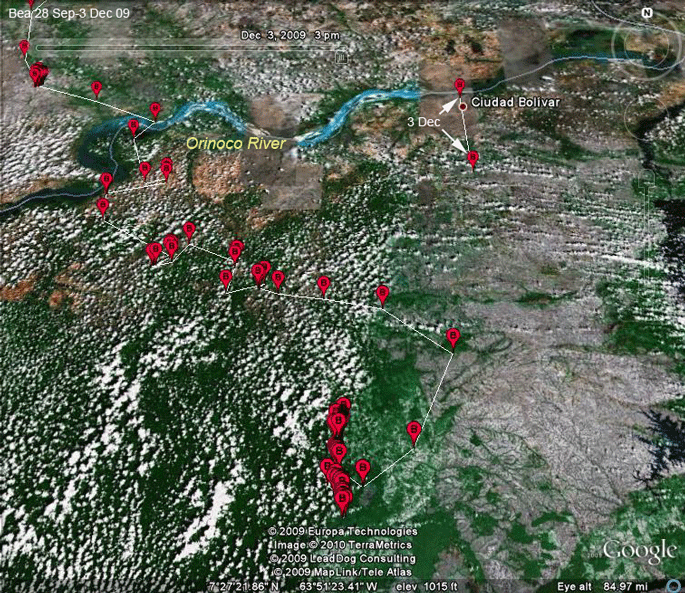 |
3 Dec 09. Imagine our
surprise when, on December 3rd, a month after the last signal from Bea's
transmitter deep in the state of Bolivar, Venezuela, we got two signals
from Ciudad Bolivar, the capital of the state. This had all the
appearances of a transmitter in the hands of a human. Shortly
thereafter, I got an email from the manufacturer of our transmitters,
forwarding an email they had just received from a Venezuelan who had
seen the transmitter and tracked down an email address for Microwave
Telemetry to inquire about it. Once again, I enlisted the help of our colleague Adrian Naveda-Rodrigues (see Isabel's maps for more on Adrian), who contacted the people involved and has pieced together the following story. |
|
|
Bea's last signals came from an Indigenous Reserve in the state of
Bolivar. A pilot who flies back and forth between Ciudad Bolivar and the
reservation was flying the wife of a rancher from
the reservation to the capital, where the rancher maintains a house in
the city. Somehow the pilot, Idelmaro, saw the transmitter and, his
curiosity piqued, wrote down the name of the manufacturer, before
returning the transmitter. The woman told Idelmaro that they had found
the Osprey dead on the ground and recovered the transmitter and band
from it. Almost certainly, the smoke was still rising from the barrel of
the rifle they used to shoot the bird when they "found it on the
ground." The woman was reluctant to return the transmitter, probably afraid of legal repercussions. Adrian got in touch with Idelmaro and somehow (details here aren't clear) the transmitter is now in the hands of a Colonel in the Venezuelan National Guard, who apparently is trying to figure out what sort of spy device the transmitter is and how the Americans co-opted an Osprey to do their nefarious work. We're still awaiting word from Adrian, who is trying to get the transmitter back for us. |
||
Birds of Prey page -- Osprey main page -- Migration page -- Home Page